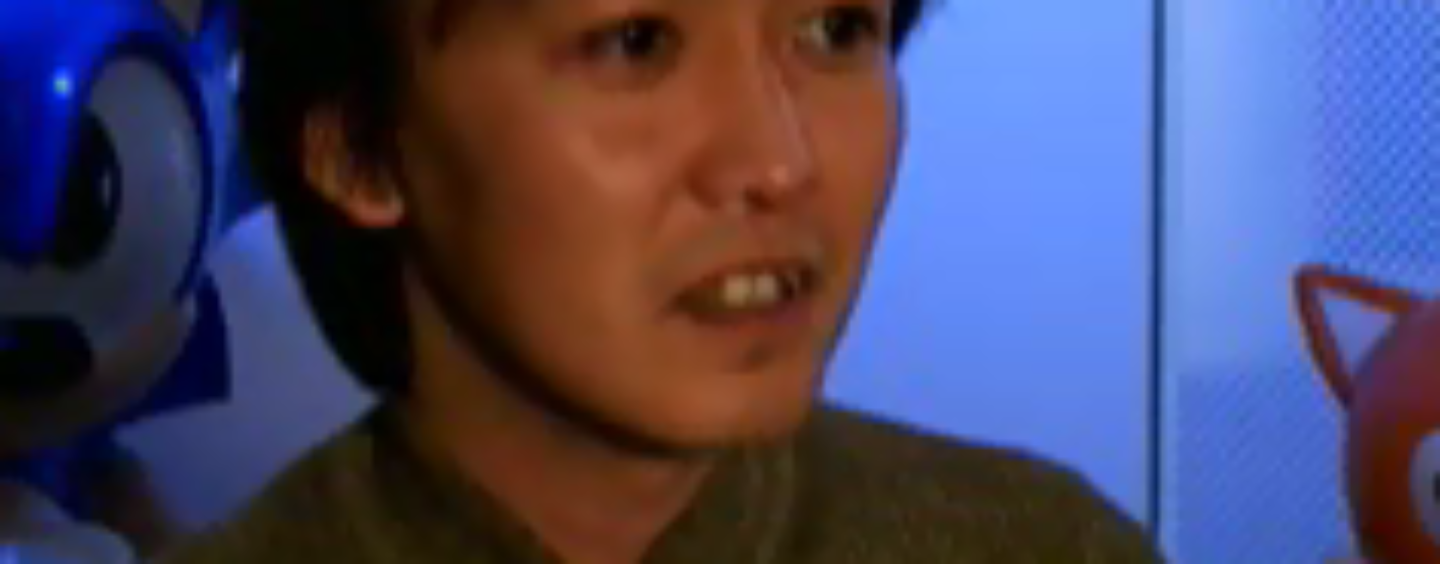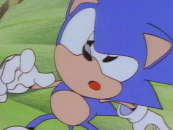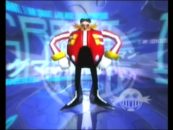This Sonic Adventure DX Directors Cut Commentary with Takashi Iizuka talks about the making of Sonic Adventure and all of the aspects of the game such as Gamma, Big, Chaos, the chao, their trip, and Sonic’s move into 3D. It’s a great video that all fans should watch.
Below we have a transcript of the whole commentary for the people that are unable to download the movie files. Part 1 and 3 were done by Bounce and Part 2 was done by Solorfrog for SoaH.
DOWNLOAD:
» Download Part 1
» Download Part 2
» Download Part 3
Takashi Iizuka’s Introduction Sonic Adventure and the Game’s Beginnings
My first experience, working on a Sonic game, was with Sonic 3. Then I worked on NiGHTS, which was a flying game, but after working on a flying game, I really wanted to work on another Sonic game, where the gameplay is much faster, and on the ground. Soon after I finished working on NiGHTS, I approached Naka-san, with a proposal, that we make an RPG style Sonic game. The idea that I had in mind, was to develop a simple RPG Sonic game. I wanted something bigger, on a bigger scale, with a heavier emphasis on story, something that we all felt was missing from other Sonic games. The game eventually became the game, which we now know as Sonic Adventure.
Taking Sonic the Hedgehog Into the Third Dimension
When we first set out to develop a Sonic 3-D game, when we knew that we needed to take Sonic to the third dimension, we knew that we had to take Sonic to a whole new level. The first question that popped into everyone’s minds, was “How would Sonic move in 3-D?” This was the issue we argued about the most.
There was no game like this at the time. What was the best way to show Sonic in 3-D? When we built our first test level, we knew we had to test it out, just to make sure our ideas worked. It ended up only lasting only 10 seconds, and we knew we couldn’t build a game around this structure. We had to re-build levels over and over again until we finally had a level length we were happy with.
There was one more issue that we had to tackle and that was the issue of the camera work. Now, normally in 3-D games, the camera follows behind the character, and this is the most basic style of camera work, but no matter what we tried, we couldn’t get the same sensation of speed as the 2-D games by doing this. We needed to figure out a different way to convey this sensation of speed. So, after extensive research on the matter, we discovered that the key really was in the camera system. We decided to develop a more dynamic camera system, one the showed Sonic from many angles, rather than just from behind, to emphasis the speed at which he moved. We went back and implemented the camera system, and we really discovered that it made all the difference.
Figuring out these two things; How to make Sonic move in a 3-D environment and what camera angles to use to emphasis the speed, were or two biggest challenges. We wanted to build something nobody had ever seen before. These challenges were much more difficult then we had originally anticipated, but we feel we have accomplished the goals that we set for ourselves.
Homing Attack
The Homing Attack was first introduced in the original Sonic Adventure game. In previous 2-D Sonic games, players could easily, and quite comfortably bounce off the heads of their enemies, and that really was part of the fun. The question was “How do you do this in 3-D?” That’s where we thought of targeting enemies while in the air. By doing this, players can bounce of one enemy, then target the next, and then the next, and then the next. This really allows players to enjoy the same speedy attacks they had in the 2-D Sonic games, in a whole new 3-D world.
Light Attack
In order to take Sonic to the third dimension, we needed several attacks and several ways to emphasis his speed. We had already thought of the Homing Attack, but we really didn’t think this was enough. We needed one more attack, one more idea, to really capture it, the sensation of speed. We gave it much thought, and that’s when we thought up the Light Attack. This attack turns Sonic into a blur really making it feel like the player is moving at Sonic’s speeds. We enjoyed this attack so much, that we decided to make it stable in the Sonic Adventure series, and it made a comeback for Sonic Adventure 2.
Gamma
Sonic games have always been about running, and running fast. But many fans voiced the opinion that they wanted to see shooting elements in a Sonic game. The problem is, that Sonic would never use a gun; it’s just not in his character. So, in order to live up to those requests, we knew as a team that we needed to do something drastic. The question is, how do you add shooting elements to a Sonic game? We decided to add a whole new character: a robot who specialized in shooting. And that’s how Gamma was born.
Chaos
As all Sonic fans know, the primary villain in every previous Sonic game had always been the notorious Doctor Eggman. But we knew that in order to make a bigger game, something with much more impact… I wanted to take advantage of the technological jump that we made going from Genesis to Dreamcast in a Sonic game. I wanted to create an enemy that hadn’t been possible until now. I wanted something bigger, something transparent and liquid, because the technology now allowed for it. I wanted something that would wow the users.
That’s when we came up with the idea for Chaos. He was larger than Sonic, and he looked much more powerful than any enemy any Sonic game has ever seen. And that’s why we wanted to add him from the very beginning, and we included him in the opening movie sequence. We wanted to make a statement. We wanted to show users from the very beginning of Sonic Adventure that this game was bigger and better. When we first designed Chaos, we presented the drawing to Naka-san, and he liked the idea so much, he approved it on the spot.
Big the Cat
Including Big the Cat, there were six characters in total in Sonic Adventure. And aside from Big, every other character was intense in some way or another. Sonic was all about speed, and Tails was always chasing Doctor Eggman, and Amy was always running away from something or other. But amidst all of them, we thought it would be a good idea to have a character who moved at his own pace, sort of nonchalantly, to change the pace of the game a little. And that’s how we thought of Big the Cat. And we figured, since Big was a cat, that, if anything, he should go fishing.
Chao
As for the Chao, the people who played NiGHTS probably already know this, but for that game we had developed what we call “A-Life”, or an artificial lifeform that lives within the world of the game. We wanted to add this element into an action game. We wanted something different for our new action game. We wanted something that felt alive and would grow with the character. The concept of A-Life was so well taken in NiGHTS that we added it to Sonic Adventure.
This not only changed up the style of the gameplay, but it allowed people who weren’t necessarily good at action games to be able to play a Sonic Game for the first time. As people spent more and more time with the Chao portions of the game, little did they know that they were actually becoming good at the rest of the game, and were soon able to actually play through the action portions as well. We really wanted to introduce Sonic to people who weren’t good at action games, and to expand the reach of the game. That’s why we included the Chao in the design; we really just wanted to expand the world of Sonic, and to expand the game to people who never had the chance to play a Sonic game before.
SONIC TEAM’s Travels
When we first set out to make Sonic Adventure, there had been such a jump in the hardware that we really wanted to make a more realistic world, and more realistic environments for the next Sonic game. We really wanted something closer to the world that we were all imagining inside our heads when we set out to make the design. And even though we wanted to create this realistic world, none of us had ever actually seen environments like ruins or jungles.
We’d all seen them in movies, but none of us had ever seen them in real life. So, we thought that in order to create a more realistic world for Sonic, the first and foremost step would be to actually see these environments with our own eyes. So, the core members of the Sonic Adventure development team, including myself, decided that we needed to go on a trip to Central and South America. If anything, we knew that there, at those loacations, we would find at the very least, inspiration to create more realistic environments for our Sonic Adventure game.
We visited the jungles, the ruins, temples and beaches in Cancoun, Guatemala and even Peru. We saw everything with our own eyes, and we ended up taking a lot of pictures as well. But that just wasn’t to get a better feel for the environments. It wasn’t to take pretty pictures home with us. We actually used these pictures as textures in the game, to create more realistic environements. For instance, for the rocks and the jungle walls in some of the levels, those are actually pictures taken on our trip. And we feel that this helped create a certain sense of realism in the game that never existed in any previous Sonic game. The inspiration, and the pictures that we took on our trip really helped add to the quality of Sonic Adventure.
TAILS’ Sandboarding
Now, the initial purpose of our trip was to see and take pictures of environments in Central and South America, for Sonic’s new world. But, as a sort of lucky accident, we were able to see something totally new that we added to the game. While we were in Peru, in a little village called Ica, we noticed some people boarding on sand dunes. We were so impressed with this; we had no idea this kind of sport actually existed. It was so new and exiting for us to see this, we knew that we had to add this element to our game. And we figured that Tails, if anyone, was the most appropriate character to use. And that’s how we created Tails’ sandboarding level in Sonic Adventure.
Why a Director’s Cut?
Sonic Adventure was released in 1999 in America on the Dreamcast. Sonic Adventure 2 Battle was released last year on the Gamecube, which marked the first time a Sonic game had been on a non-Sega home platform. There are many people who played a Sonic game for the first time when they played Sonic Adventure 2 Battle on Gamecube. But those same people never played the original Sonic Adventure, and were curious about the first game in the series. Well, it’s now 2003, and it’s been a while since the original was released. So, we decided that we should release a director’s cut. We wanted to show people the creativity of Sega by showcasing a classic that we put a lot of effort into making, and that has many great hours of gameplay. We felt that the original Sonic Adventure was the perfect candidate to show the size, and quality, of every Sonic game. So, we wanted to re-create the original Sonic Adventure on Gamecube, and introduce it to a whole new generation of gamers, with all of the improvements that we were unable to add to the original. And that’s really why we decided to release Sonic Adventure DX Director’s Cut.
There were really two significant reasons, in addition to the one I just mentioned, as to why we decided to make Sonic Adventure DX. Not only did we want to bring the original Sonic Adventure to a new fanbase, we wanted to appeal to the fans who loved the original on the Dreamcast. And in order to accomplish both of these goals, killing two birds with one stone in a sense, we decided to add a whole slew of new features to Sonic Adventure DX. Simply put, we decided to go back and upgrade all the character models in the game. Not only that, we upgraded the quality of the environments as well. We really wanted this game to graphically shine. We felt that with these new graphical improvements, the game would be closer to what we had originally envisioned. Also, to make things easier for the player, we decided to add a 2D map system. Basically, when the player presses the pause button, a two-dimensional map of the level pops up on-screen, and lets the player know where they need to go. We also decided to go back and redo the Chao portions of the game. We really wanted the Chao to feel more alive, and more organic than in the original. Also, for the fans of the original on the Dreamcast, we decided to add what we call “Mission Mode”, to change the pace of the game. It really does change the way that the game is played. The user finds the missions, and has to solve each mission, almost like a treasure hunt. We really wanted this new feature to appeal to the fans of the original on the Dreamcast. And that’s why we decided to add sixty missions for players to enjoy.
Perhaps some people aren’t aware of this, but there actually was an entire line of Sonic games available on Sega’s old Game Gear system. And until now they were only available on the Game Gear, which is why we really wanted to include these on Sonic Adventure DX. We felt that there were many fans of the series who never got a chance to play these games. So, as you play through Sonic Adventure DX, you can unlock these games one by one. The more you play, the more there is to play. We took the original Sonic Adventure, which was huge in it’s own right, and added the Mission Mode and all of the Game Gear games. And we believe that, with Sonic Adventure DX, we have created a game that has more volume and more fun packed in than almost any other game on the market. We really feel that this game appeals to both new fans of the series, and fans of the original. Not only do you get the original Sonic Adventure, you get all new modes, and an entire series of games that you can unlock. We truly hope that people who play Sonic Adventure DX will enjoy the game, and will enjoy playing through all these new features that we’ve added.





No Comments so far
Jump into a conversationNo Comments Yet!
You can be the one to start a conversation.